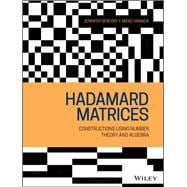Up-to-date resource on Hadamard matrices
Hadamard Matrices: Constructions using Number Theory and Algebra provides students with a discussion of the basic definitions used for Hadamard Matrices as well as more advanced topics in the subject, including:
- Gauss sums, Jacobi sums and relative Gauss sums
- Cyclotomic numbers
- Plug-in matrices, arrays, sequences and M-structure
- Galois rings and Menon Hadamard differences sets
- Paley difference sets and Paley type partial difference sets
- Symmetric Hadamard matrices, skew Hadamard matrices and amicable Hadamard matrices
- A discussion of asymptotic existence of Hadamard matrices
- Maximal determinant matrices, embeddability of Hadamard matrices and growth problem for Hadamard matrices
The book can be used as a textbook for graduate courses in combinatorics, or as a reference for researchers studying Hadamard matrices.
Utilized in the fields of signal processing and design experiments, Hadamard matrices have been used for 150 years, and remain practical today. Hadamard Matrices combines a thorough discussion of the basic concepts underlying the subject matter with more advanced applications that will be of interest to experts in the area.








